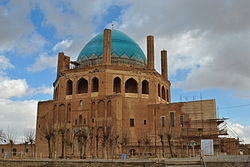- Soltaniyeh
-
For the administrative subdivision, see Soltaniyeh District.
Soltaniyeh
سلطانيه— city — Soltaniyeh Dome Coordinates: 36°26′05″N 48°47′51″E / 36.43472°N 48.7975°ECoordinates: 36°26′05″N 48°47′51″E / 36.43472°N 48.7975°E Country  Iran
IranProvince Zanjan County Abhar Bakhsh Soltaniyeh Population (2006) – Total 5,684 Time zone IRST (UTC+3:30) – Summer (DST) IRDT (UTC+4:30) Soltaniyeh * UNESCO World Heritage Site
Country  Iran (Islamic Republic of)
Iran (Islamic Republic of)Type Cultural Criteria ii, iii, iv Reference 1188 Region ** Asia-Pacific Inscription history Inscription 2005 (29th Session) * Name as inscribed on World Heritage List
** Region as classified by UNESCOSoltaniyeh (Persian: سلطانيه, also Romanized as Solţānīyeh, Solţāneyyeh, Sultaniye, and Sultānīyeh; also known as Sa‘īdīyeh)[1] is a city in and capital of Soltaniyeh District of Abhar County, Zanjan Province, Iran. At the 2006 census, its population was 5,684, in 1,649 families.[2] Soltaniyeh, located some 240 kilometres (150 mi) to the north-west of Tehran, used to be the capital of Mongol Ilkhanid rulers of Persia in the 14th century. Its name translates as "the Imperial". In 2005, UNESCO listed Soltaniyeh as one of the World Heritage Sites.
William Dalrymple notes that Öljaitü intended Soltaniyeh to be "the largest and most magnificent city in the world" but that it "died with him" and is now "a deserted, crumbling spread of ruins."[3]
Contents
Dome of Soltaniyeh
The central magnet of Soltaniyeh's several ruins is the Mausoleum of Il-khan Öljeitü (Persian اولجايتو) also known as Muhammad Khodabandeh, traditionally known as the Dome of Soltaniyeh.
The structure, erected from 1302 to 1312 AD, has the oldest double-shell dome in Iran.[4] Its importance in the Muslim world may be compared to that of Brunelleschi's cupola for Christian architecture. It is one of the largest brick domes in the world, just at the theoretical engineering limit for a brick dome and the third largest dome in the world after domes of Florence Cathedral and Hagia Sophia.[5] The Dome of Soltaniyeh paved the way for more daring Iranian-style cupola constructions in Muslim world, such as the Mausoleum of Khoja Ahmed Yasavi and Taj Mahal. Much of its exterior decoration has been lost, but the interior retains superb mosaics, faience, and murals. People have described the architecture of the building as “anticipating the Taj Mahal.”
The estimated[weasel words] 200 ton dome stands 49 meters (161 ft) tall from its base, and is currently[when?] undergoing extensive renovation.
Photo gallery
-
The Soltaniyeh Dome's structure and its 6 minarets are being restored by Iran's ICHO
See also
External links
- Official website
- World Heritage profile
- Video of Soltaniyeh
- Farnoush Tehrāni, The Crown of All Domes, in Persian, Jadid Online, 31 December 2009, [1].
• Audio slideshow: [2] (6 min 45 sec).
References
- ^ Soltaniyeh can be found at GEOnet Names Server, at this link, by opening the Advanced Search box, entering "-3081931" in the "Unique Feature Id" form, and clicking on "Search Database".
- ^ "Census of the Islamic Republic of Iran, 1385 (2006)" (Excel). Islamic Republic of Iran. http://www.amar.org.ir/DesktopModules/FTPManager/upload/upload2360/newjkh/newjkh/19.xls.
- ^ Dalrymple, William (1989). In Xanadu. pp. 128–129.
- ^ http://www.iranreview.org/content/view/2280/51/
- ^ http://www.iranreview.org/content/view/2280/51/
Architecture of Iran Styles Parsi style · (includes Pre-Parsi style and Achaemenid architecture)
Parthian style · (includes Sassanid architecture)
Khorasani style · Razi style · Azari style · Isfahani style
Elements Notable traditional cities Architecture of Tehran · Bam · Bukhara · Ctesiphon · Derbent · Herat · Isfahan · Kashan · Merv · Mashhad · · Nishapur · Persepolis · Qazvin · Qom · Samarkand · Shahrisabz · Shiraz · Susa · Tabriz · Takht-i-Suleiman · Yazd · Gur-e AmirTheory and Analysis Lists World Heritage Sites in Iran The Armenian Monastic Ensembles of Iran (St Thaddeus Monastery, St Stepanos Monastery, Chapel of Dzordzor, Chapel of Chupan, and Church of the Holy Mother of God) · Bam and its Cultural Landscape · Bistoun · Chogha Zanbil · Naqsh-e Jahan Square · Pasargadae · Persepolis · The Persian Gardens (Pasargad Pserian, Chehel Sotoun, Fin, Eram, Shazdeh, Dolatabad, Abbasabad, Akbarieh and Pahlevanpour) · Sheikh Safi's Tomb · Soltaniyeh · Shushtar Historical Hydraulic System · Tabriz Bazaar · Takht-i-Suleiman
 Zanjan Province
Zanjan ProvinceCapital Zanjan
Counties and Cities Ijrud CountyZarrinabad · HalabQidar · Garmab · Sohrevard · Sojas · Zarrin RudKhorramdarrehZanjan · ArmaghankhanehSights Sharshar waterfall • Zanjan Bazzar • Rakhtshooy Khaneh Edifice • Karsaf Tappe • Darband ghaterchi • Kharmaneh cave • Katale Khor • Behestan castle • Molla Hassan Kashi Mausoleum • Soltaniyeh • Seyyed Mosque • Dragon temple • Zanjan Museum • Caspian international fairCategories:- World Heritage Sites in Iran
- Buildings and structures in Iran
- Domes
- Iranian architecture
- 1300s architecture
- Abhar County
- Cities in Iran
- Cities in Zanjan Province
- Ilkhanate
-
Wikimedia Foundation. 2010.







